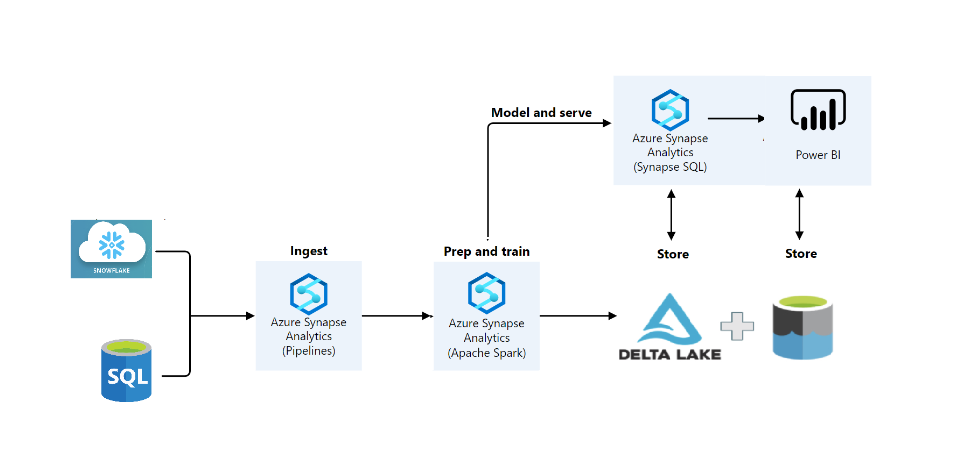
Problem Statement
A leading enterprise confronted significant challenges with their existing infrastructure, specifically experiencing performance issues and delayed analytics insights with their on-premises SQL server. Additionally, escalating costs associated with Snowflake and the absence of a unified analytics platform underscored the need for a scalable, efficient, and cost-effective solution. Recognizing these limitations, the client embarked on a strategic migration journey to Azure Synapse Analytics, Azure SQL, and other Azure services, aiming to enhance performance, achieve cost savings, and leverage unified analytics capabilities.
Solution Overview
To address the multifaceted challenges presented by the client’s existing infrastructure, a comprehensive and phased approach was adopted:
- Planning and Assessment: A comprehensive evaluation identified schema structures, dependencies, and performance bottlenecks, laying the groundwork for a seamless migration strategy.
- Migration Execution: Leveraged Azure Data Factory for data migration from on-premises SQL and Snowflake to Azure SQL and Delta Lake within Azure Synapse Analytics, emphasizing rigorous data validation.
- Optimization and Integration: Post-migration, optimization measures in Azure SQL and integration of Delta Lake with Azure Synapse Analytics were implemented, deploying data partitioning and indexing strategies for enhanced performance.
- Post-Migration Support: Comprehensive testing, performance monitoring, and training sessions for the client’s teams were instituted, ensuring proficiency and proactive support mechanisms.
By adopting this structured and holistic approach, the solution not only addressed the client’s immediate challenges but also laid a robust foundation for enhanced data management, analytics capabilities, and scalability, positioning them for sustained growth and innovation in an evolving business landscape.
Tech Stack leveraged
The deployment has below tech components
Cloud Platform
- Microsoft Azure: Chosen as the primary cloud platform for hosting and managing the data migration and analytics solutions.
Data Migration and Orchestration
- Azure Data Factory: Utilized for orchestrating and automating the movement of data from on-premises SQL and Snowflake to Azure SQL and Delta Lake within Azure Synapse Analytics.
Data Storage and Analytics
- Azure SQL: Selected as the target database for migrating data from the client’s on-premises SQL server, offering scalability and advanced indexing capabilities.
- Delta Lake: Implemented within Azure Synapse Analytics to store and manage structured and semi-structured data, facilitating seamless analytics processing.
Unified Analytics Platform
- Azure Synapse Analytics: Centralized platform leveraged for data integration, analytics, optimization, and integration. This platform enabled the client to analyze both structured and semi-structured data sources from a unified interface.
Performance Optimization
- Synapse SQL Pools: Utilized within Azure Synapse Analytics for optimizing query performance and processing capabilities.
Data Governance and Security
- Azure Purview: Integrated within Azure Synapse Analytics to strengthen data governance through classification, lineage tracking, and enhanced security measures.
Real-time Data Processing
- Azure Stream Analytics: Identified for future implementation to enable real-time data processing and immediate insights from streaming data sources.
CI/CD Pipelines
- Azure Data Factory: Established CI/CD pipelines for automated testing and deployment, ensuring consistent and reliable data pipeline updates and maintenance.
Serverless Data Exploration:
- Serverless SQL Pool in Azure Synapse Analytics: Highlighted for future implementation, enabling ad-hoc data exploration and analysis without the need for dedicated resources.
By leveraging this comprehensive tech stack, the solution effectively addressed the client’s challenges, offering scalability, performance optimization, unified analytics capabilities, and robust data governance within the Azure ecosystem.
Benefits Delivered
- Enhanced Performance: The migration to Azure SQL and Delta Lake resulted in significantly improved data query and analytics performance, addressing the performance issues previously experienced with the on-premises SQL server. Users can now access and analyze data more efficiently, leading to quicker decision-making processes.
- Cost Savings: The adoption of Azure SQL and Delta Lake, coupled with optimized configurations, led to substantial cost savings for the client. By moving away from the costly scaling model of Snowflake, the client achieved a more cost-effective solution that aligns with their budgetary requirements.
- Unified Analytics Platform: Azure Synapse Analytics provided a centralized and unified analytics platform, enabling the client to seamlessly analyze both structured and semi-structured data from a single interface. This integrated approach fosters collaboration, streamlines workflows, and enhances data-driven insights across the organization.
- Scalability: The cloud-based solution offers scalability on-demand, allowing the client to adjust resources based on fluctuating data volumes and analytics requirements. This scalability ensures that the client’s infrastructure can adapt and grow in alignment with evolving business needs without compromising performance or efficiency.
- Improved Data Management: The implementation of Azure Purview and other governance measures enhanced data management capabilities by providing classification, lineage tracking, and enhanced security measures. This ensures data integrity, compliance, and security, fostering trust and reliability within the organization.
- Future-Ready Infrastructure: By adopting a cloud-based solution and leveraging advanced technologies within the Azure ecosystem, the client has positioned themselves for future growth, innovation, and scalability. The flexible and adaptable infrastructure enables the client to explore emerging technologies, implement real-time data processing, and drive continuous improvement initiatives.
- Operational Efficiency: The automation and optimization of data integration, migration, and analytics processes have streamlined operations, reduced manual intervention, and enhanced efficiency. This allows the client’s teams to focus on strategic initiatives, innovation, and value-added activities rather than routine maintenance and management tasks.
- Training and Skill Development: The provision of training sessions for the client’s analytics and IT teams ensures proficiency in the new environment, fostering skill development, knowledge sharing, and empowerment. This equips the client’s teams with the necessary skills and expertise to leverage the new platform effectively, driving adoption, and maximizing ROI.
In summary, the comprehensive migration and integration project delivered a myriad of benefits, including enhanced performance, cost savings, unified analytics capabilities, scalability, improved data management, operational efficiency, and skill development, positioning the client for sustained success and growth in an increasingly competitive and data-driven landscape.

